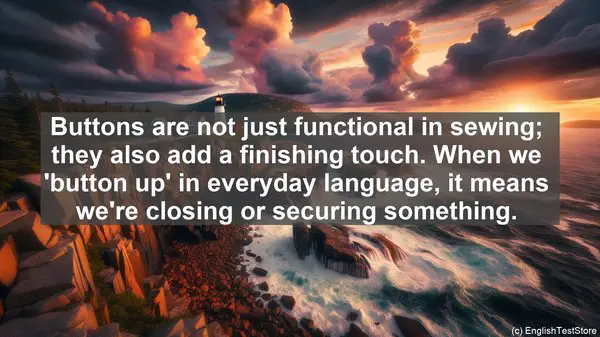Introduction: The Thread That Connects Language and Sewing
Hello, students! Did you know that language and sewing have something in common? Just like a needle and thread, idioms stitch our words together, creating vivid expressions. Today, we’ll explore 10 idioms that have their roots in the world of hand sewing. Let’s get started!
1. ‘Cut From the Same Cloth’
When we say two people are ‘cut from the same cloth,’ it means they have similar qualities or characteristics. Just like pieces of fabric cut from the same roll, these individuals share common traits. So, if you and your best friend have a lot in common, you can say, ‘We’re definitely cut from the same cloth!’
2. ‘Threadbare’
Imagine a piece of fabric that’s been used so much that it’s worn out, with threads showing. That’s exactly what ‘threadbare’ means. However, when we use it to describe something other than fabric, like an excuse or an argument, it implies that it’s overused or lacking substance. So, if someone presents a weak argument, you can say, ‘That excuse is threadbare.’
3. ‘Seamless’
In sewing, a ‘seam’ is where two pieces of fabric are joined together. When a seam is ‘seamless,’ it means the join is so smooth that you can’t see any trace of it. In everyday language, ‘seamless’ refers to something that’s perfectly smooth or without any interruptions. For example, if a plan goes off without a hitch, you can say, ‘It was a seamless operation.’
4. ‘Pin Down’
When you’re sewing, you use pins to hold the fabric in place. Similarly, when we ‘pin down’ something in a conversation or a situation, it means we’re trying to get a clear answer or a definite solution. For instance, if you’re discussing a complex problem, you might say, ‘Let’s try to pin down the main issue here.’
5. ‘Patch Things Up’
In sewing, a ‘patch’ is a piece of fabric used to cover a hole or mend a tear. When we ‘patch things up’ in a relationship or a situation, it means we’re trying to fix or resolve the problem. So, if you and your sibling have an argument, you can say, ‘We need to sit down and patch things up.’
6. ‘In Stitches’
When you’re sewing, ‘stitches’ are the small loops or knots that hold the fabric together. But when we say we’re ‘in stitches,’ it means we’re laughing uncontrollably. So, if a joke is really funny, you can say, ‘It had me in stitches!’
7. ‘Measure Up’
In sewing, ‘measuring’ is essential to ensure a garment fits perfectly. When we say someone ‘measures up’ to a certain standard, it means they meet the expectations or requirements. For example, if a student performs exceptionally well in an exam, you can say, ‘They really measured up to the challenge.’
8. ‘Button Up’
Buttons are not just functional in sewing; they also add a finishing touch. When we ‘button up’ in everyday language, it means we’re closing or securing something. It could be a literal action, like buttoning up a coat, or a metaphorical one, like finalizing a project. So, if you’re about to leave a meeting, you might say, ‘Let’s button up the discussion and move on.’
9. ‘Unravel’
In sewing, ‘unraveling’ is when the threads of a fabric come apart, leading to a mess. When we use ‘unravel’ in a non-sewing context, it means something is gradually falling apart or becoming chaotic. For instance, if a plan is not going as expected, you can say, ‘It’s starting to unravel.’

10. ‘Sew the Seeds’
In sewing, ‘sewing the seeds’ refers to the act of planting seeds in the ground. Metaphorically, when we ‘sew the seeds’ of something, it means we’re initiating or starting it. For example, if you have an idea for a project, you can say, ‘I’m planning to sew the seeds of a new initiative.’
Conclusion: The Tapestry of Language
And there you have it, students! 10 idioms that beautifully weave together the worlds of language and hand sewing. By incorporating these expressions into your conversations, you’ll not only add color but also showcase your understanding of the rich tapestry of English. Happy sewing, both with your hands and your words! Until next time!

